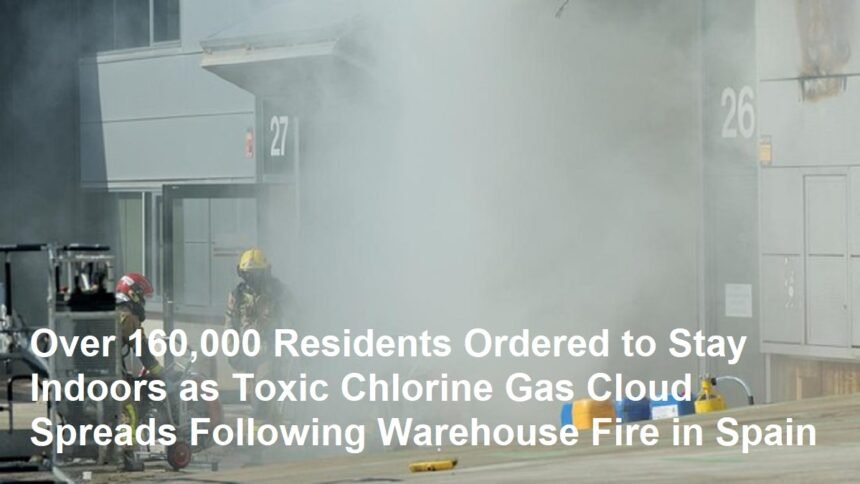On Saturday, May 10, 2025, a significant emergency unfolded near Barcelona, Spain, when a fire broke out at an industrial warehouse in the coastal city of Vilanova i la Geltrú. This warehouse stored pool cleaning products, including chlorine-based chemicals, and the blaze led to the release of a dangerous cloud of chlorine gas into the atmosphere. As a result, local authorities ordered more than 160,000 residents across five nearby districts to remain indoors as a precautionary measure to protect public health and safety.
The Incident and Its Location
The fire started at dawn in the warehouse located in an industrial estate south of Barcelona. The facility stored various chemicals used for pool maintenance, with chlorine being a key component. When the fire ignited, it caused the release of toxic chlorine gas, which is highly hazardous to human health. Chlorine gas is a potent irritant to the respiratory system and can cause severe breathing difficulties, eye irritation, and other health complications if inhaled in significant quantities.
The affected area stretched across five local districts along the Catalonian coast, from Vilanova i la Geltrú to the village of Calafell near Tarragona. This wide geographic impact prompted swift action from emergency services and local government officials to minimize exposure and potential harm to residents.
Authorities’ Response and Public Safety Measures
In response to the incident, Catalonia’s Civil Protection service and local authorities immediately issued a shelter-in-place order. Residents in the affected districts were instructed to stay inside their homes, close all windows and doors, and avoid outdoor activities. To further limit exposure, roads leading into the affected zones were closed, and train stations serving the area were temporarily shut down to prevent people from entering the hazardous zone.
Nuria Parlon, Catalonia’s Interior Minister, held a press conference to update the public on the situation. She announced that the lockdown was lifted around midday once the immediate threat had diminished. However, she cautioned that children, individuals with respiratory or other health conditions, and vulnerable populations should continue to remain indoors for a longer period. She also advised against outdoor exercise, as some dangerous chlorine particles might still linger in the air despite the fire being under control.
Firefighters and emergency responders remained on high alert, monitoring wind patterns and the movement of the toxic cloud. They warned that additional shelter-in-place orders could be issued if the chlorine gas spread further due to changing weather conditions.
Health and Environmental Concerns
Chlorine gas exposure poses serious health risks, especially to the respiratory system. Inhalation can cause coughing, chest tightness, shortness of breath, and in severe cases, pulmonary edema. The quick action by authorities to confine residents indoors was crucial in preventing widespread health emergencies. Fortunately, as of the latest reports, no casualties or serious injuries have been reported, a testament to the effectiveness of the emergency response.
Environmental concerns also arose due to the release of chlorine gas, which can be harmful to local flora and fauna. Authorities are conducting ongoing air quality monitoring and environmental assessments to evaluate the impact and ensure that the area is safe for residents to resume normal activities.
International Attention and Travel Advisories
The incident attracted international attention, with the UK Foreign Office issuing an urgent alert to holidaymakers and travelers in the region. The advisory urged people in the affected areas to follow local authorities’ instructions carefully, emphasizing the importance of staying indoors and keeping windows and doors closed to avoid exposure to the toxic cloud.
Broader Implications and Preparedness
This event highlights the risks associated with storing hazardous chemicals in industrial areas near populated regions. It underscores the importance of stringent safety protocols, emergency preparedness, and rapid response capabilities to mitigate the effects of industrial accidents. The swift coordination between emergency services, government officials, and the community played a vital role in minimizing harm.
Moving forward, investigations are underway to determine the exact cause of the fire and to assess whether safety regulations were adequately followed. Lessons learned from this incident may lead to enhanced safety standards and preventive measures to avoid similar occurrences in the future.
Conclusion
The chlorine gas cloud resulting from the warehouse fire near Barcelona on May 10, 2025, prompted a large-scale emergency response that successfully protected over 160,000 residents from potential harm. The coordinated efforts of local authorities, emergency responders, and the community ensured that the toxic threat was contained with no reported casualties. While the immediate danger has passed, ongoing vigilance remains essential to safeguard public health and the environment. This incident serves as a stark reminder of the hazards posed by industrial chemicals and the critical need for preparedness and rapid action in the face of such emergencies.









